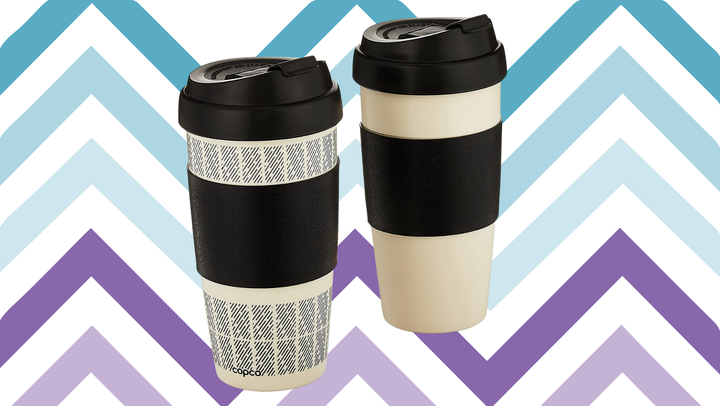
Many of us became experts at brewing coffee at home during the pandemic but are now out and about again, comfortable with visiting our local coffee shop for that daily caffeine fix again. Hallelujah!
But after a year or more of drinking out of a ceramic mug at home, you may suddenly be looking at that paper or plastic to-go cup and thinking, “How bad is this for the environment, exactly?”
According to Isaac Emery, founder and principal consultant at Informed Sustainability Consulting, it’s not great.
“Single-use items just aren’t sustainable,” Emery tells HuffPost. “Sustainability can mean a lot of different things, but under no circumstances does it mean using something once and disposing of it. There will always be an environmental cost to that.”
Wait, can’t I recycle my paper and plastic to-go cups?
While we generally think of paper as recyclable, Emery says that the waxy lining that keeps disposable cups from falling apart when they’re full of liquid makes this challenging. Starbucks, for example, has spent years trying to figure out how to make its paper cups recyclable.
“Paper cups are generally paper wrapped internally with a polymer (plastic) lining and therefore can’t be recycled and have to generally be sent to landfill,” says Mark Driscoll, sustainability expert and founder of the consultancy Tasting the Future. “However, those marked as ‘biodegradable or compostable’ cups typically use a poly (lactic acid) lining and can be composted.”
Unfortunately, most of those still end up in landfills due to a lack of composting facilities or the costs associated with getting them composted. Plus, “to meet the demand for paperboard (paper used in cups), trees can be cut down from as far away as Russia and Brazil, and most are still not [made] from recycled paper,” Driscoll noted. “To ensure cups use paperboard from sustainable timber sources, seek out the FSC (forestry stewardship logo).”
Many of the plastic cups used for iced beverages aren’t accepted by recycling programs, either. “Most are made from polypropylene that is not accepted in many curbside recycling programs,” Driscoll says.
Coffee cup sustainability, ranked
Feeling like you need to give up your coffee to-go habit altogether? Not so fast. Some to-go coffee methods are more environmentally friendly than others. Here, Driscoll and Emery rank all the to-go cup options:
Ceramic mug at the coffee shop: A
Sitting in – or out – an drinking from a ceramic mug is the most sustainable way to drink coffee from a coffee shop, according to Emery. Because these can be washed in a dishwasher, they use less energy (and less soap) than something that has to be hand-washed, like a travel mug.
“Sustainability can mean a lot of different things, but under no circumstances does it mean using something once and disposing of it.”
- Isaac Emery, founder and principal consultant at Informed Sustainability Consulting
Travel mug: B
If you bring your own travel cup, it’s a much better option than single-use cups, but it’s also not perfect. Emery says “there are environmental impacts through manufacturing materials like stainless steel, or worse, plastic to-go cups. A plastic travel cup is heavy, which means there’s a lot of plastic in it.”
But if you use it often enough, a travel to-go mug can be a very environmentally friendly option. “If you’re using your travel mug 50, 100 or 200 times, the environmental cost goes way down,” Emery says.

Paper to-go cup without a lid: C
By skipping the plastic lid, you’ll use less plastic (although your beverage will get cold faster). “This is upgraded to a B if [the cup] has a biodegradable, plant-based lining,” Driscoll notes.
Paper to-go cup with a lid: D
Because a lid adds additional plastic, it’s worse for the environment than a paper cup without a lid.
Plastic to-go cup: F
Unfortunately, there are very few ways to win if you’re buying an iced coffee beverage that comes in a plastic cup. “The plastic cups used for iced drinks are problematic and often not accepted in recycling programs,” Driscoll says.
And while paper straws are better than plastic straws (the less plastic we use, the better), Emery points out that once they’re covered in coffee, they’re not recyclable.
A word on the type of coffee you choose
Emery notes that if you want to reduce your carbon footprint even while choosing a to-go cup that might not be great for the environment, you can try to opt for a more sustainable coffee beverage.
“Your actual drink has a bigger environmental impact than the coffee cup,” he says. “So if you want to offset some of the impact of your to-go cup, get a more environmentally friendly drink.”
One way to do that is to choose plant-based milk over dairy milk because it has a smaller carbon footprint. Or better yet, take your coffee black.
“Milk is the most harmful to the environment, followed by coffee, followed by the cup. If you want to choose the best beverage for the environment, order an Americano or black coffee,” Emery says.
Now that you understand exactly how to make your to-go coffee drink more sustainable, you can go back to worrying about the havoc it’s wreaking on your bank account.